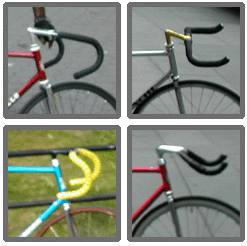No Brakes
Why no brakes?
What about panic stops?
What else do you do?

What about panic stops?
What else do you do?
Brakes or no? It's a deeply personal preference. There are many fixed-gear riders who ride with front and rear brakes, or just the front brake. Entry-level track bikes and off-the-shelf street fixes usually come with brakes, or at least brake holes in the front fork.
To find a bike with no brake holes, you must go to track-specific or custom frames.
Why no brakes?
- There are no brakes in the velodrome.
- Brakes are not needed for safety, if you know how to control your bike, slow and stop.
- Your legs are your brakes.
- Your awareness is heightened without brakes. Many old skool riders have the definite feeling of lowered awareness of "falling asleep" on the bike if it has brakes.
- As you ride, you feel connected with everything. See "No Brakes -- Or, Zen on Wheels."
- This is the full flavor and beauty of fixed-gear riding.
- A track bike is a beautiful, elegant machine, a piece of jewelry in motion.
- Brakes and brake holes are fugly on the frame.
Personally, I'd have much more fun on a road bike than a fix with brakes.
What about panic stops?
True, the panic-stopping distance is longer on a track bike than on a road or mountain bike. So how do you stop?
There are several ways to handle this, and it's not just about stopping. It's about the whole way you ride. To stop quickly:
- Skids and skips. These will stop, though not as abruptly as brakes.
- Skid combined with power-slide. As you skid, you pull the back wheel around towards the front, orienting your body and front wheel towards the side. It's similar to what you might have done on a dirt bike as a kid. You minimize your linear stopping distance, but you'll require more side-to-side space as your rear wheel slides out to the side and around. Most people have a dominant direction, for both the direction of the slide, as well as the position of the pedals. For me, it's a counterclockwise twist, the rear wheel coming around the right to the front, while the pedals are at 3 and
9 o'clock, left foot forward. My body is used to this configuration, from years of coaster brake riding, as well as skateboarding and inline skating. But admittedly, I do not use this technique too much, since I hardly ever panic-stop.
So what else do you do?
 There are more tips on how to ride, control and stop in my Fixed-Gear 101, on the www.63xc.com site.
There are more tips on how to ride, control and stop in my Fixed-Gear 101, on the www.63xc.com site.- Ride in a different rhythm. If you see accomplished messengers on a track bike on a busy city street, you'll see a distinct smoothness. Not as many fast accelerations/decelerations as the riders on mountain bikes use. And they almost never, ever stop. There are also trackstands. Years ago, a track-bike messenger was being interviewed by a NYC magazine. He said, "Riding a track bike in Manhattan, you can go from Chinatown to 125th Street and never put a foot down."
- Find a hole and go through it. I too almost never stop. I look much farther ahead, anticipating traffic patterns and possibilities further in advance. I look for gaps in car traffic and foot traffic. My gear is in the high 60's, which allows me to sprint across the street if necessary, as well as skip or backpedal as necessary.
- Use the "Instaturn." If you're in the right lane and a car swerves in front of you, turning right -- do a quick turn to the right, inside the car's radius. Watch for drainage gates as you approach the curb, because they can swallow your front tire. I try to jump them. More about the Instaturn, with diagram, on the Bicycling Life page.
- Look farther ahead. This is natural as soon as you take the brake off. And it gives you the extra time, seeing what's going on.
- Use peripheral vision. This is another natural with no brakes - it encourages your peripheral vision to expand.
- Use your ears and ESP. Try to hear and sense the cars behind you and out to the side. Some riders sport headphones and music -- I don't.
- Watch for driver cues. There could be a whole article on this. You see a driver in a car parked along the curb. What they will do? Door you? Pull out in front of you?
Cues to a door opening: you hear a click, or the driver leans away from the door as their hand reaches the handle, or they look rearwards through the window to check on traffic (they actually do this sometimes!), or they give a quick goodbye kiss to the other party in the car.
Cues to the car pulling out: turn signal (yeah, right!), the front tires turning towards the traffic, the driver's shoulders heaving or hands moving as they crank the steering wheel, the telltale glance over their shoulder.
© Greg Goode, 2003
